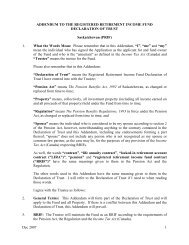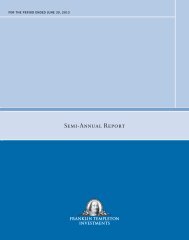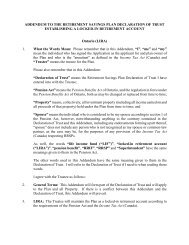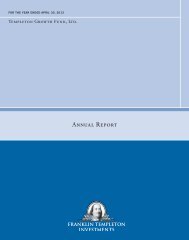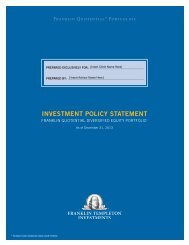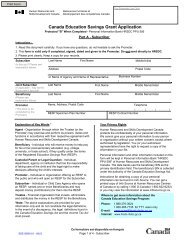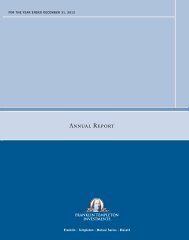PDF Version
PDF Version
PDF Version
Create successful ePaper yourself
Turn your PDF publications into a flip-book with our unique Google optimized e-Paper software.
As of September 30, 2009, approximately 58% of our definite-lived intangible assets related toinvestment management contracts of Fiduciary Trust Company International (“FTCI”) high net-worthaccounts. We estimated the future undiscounted cash flows for the contracts using assets under managementgrowth rates ranging from 0.3% to 0.5% and the future discounted cash flows using a discount rate of13.9%. We did not recognize an impairment loss because the fair value of the contracts exceeded theircarrying value. As of September 30, 2009, a decline in our assets under management of approximately 40%could cause our FTCI high net-worth management contracts to be impaired.The undiscounted future cash flow projections for the remaining 42% of our definite-lived intangibleassets exceeded their respective carrying values by more than 30%. We estimated the undiscounted futurecash flows using assets under management growth rates ranging from (6.2)% to 6.0%, depending on thetype of management contracts. As of September 30, 2009, a decline in our assets under management ofapproximately 40% could cause us to evaluate whether the fair value of our other definite-lived intangibleassets is below the asset carrying value.While we believe that our impairment tests and the assumptions used to estimate fair value arereasonable and appropriate, if the assumptions used in our estimates of fair value change in the future, wemay be required to record impairment charges or otherwise accelerate amortization expense.RevenuesWe recognize investment management fees, shareholder servicing fees and distribution fees as earnedover the period in which services are rendered, except for performance-based investment management fees,which are recognized when earned. We recognize underwriting commissions related to the sale of shares ofour sponsored investment products on the trade date. Investment management fees are generally determinedbased on a percentage of assets under management, except for performance-based investment managementfees, which are based on performance targets established in the related investment management contracts.Generally, shareholder servicing fees are calculated based on the number and type of accounts serviced,while distribution fees are generally based on a percentage of assets under management.Assets under management is calculated for our sponsored investment products using fair valuemethods derived primarily from unadjusted quoted market prices, unadjusted independent third-party brokeror dealer price quotes in active markets, or adjusted market prices or price quotes. The fair values ofsecurities for which market prices are not readily available are internally valued using variousmethodologies as appropriate for each security type. Securities for which market prices are not readilyavailable generally represent a de minimus amount of our total assets under management. The pricing of thesecurities held by our sponsored investment products is governed by a global valuation and pricing policy,which defines valuation and pricing conventions for each security type, including practices for respondingto unexpected or unusual market events. While recent economic conditions and financial market declineshave increased market price volatility, the fair value of the majority of the securities held by the sponsoredinvestment products continues to be derived from readily available market price quotations.Income TaxesWe record deferred tax assets and liabilities for temporary differences between the tax basis of assetsand liabilities, and the reported amounts in the consolidated financial statements using the statutory tax ratesin effect for the year when the reported amount of the asset or liability is recovered or settled, respectively.The effect on deferred tax assets and liabilities of a change in tax rates is recognized in the results ofoperations in the period that includes the enactment date. A valuation allowance is recorded to reduce thecarrying values of deferred tax assets to the amount that is more likely than not to be realized. For each taxposition taken or expected to be taken in a tax return, we determine whether it is more likely than not that57



